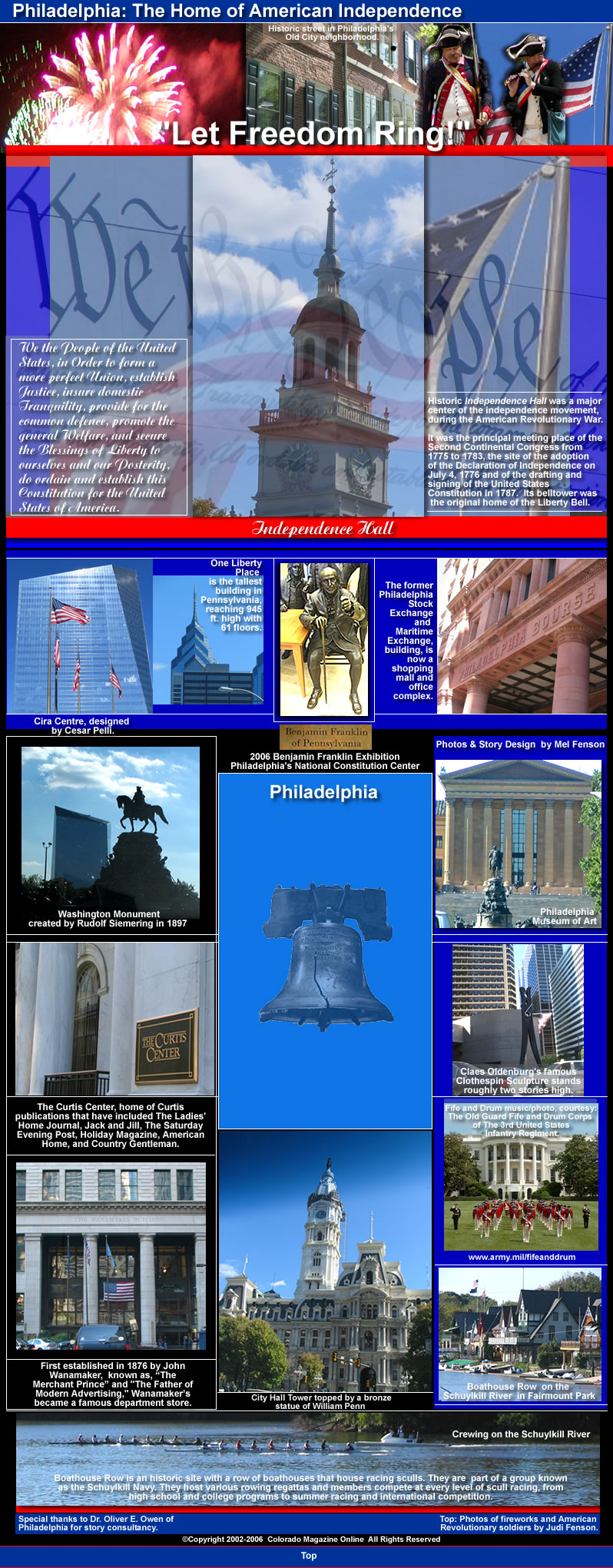

Philadelphia served as the nation’s first capital from 1790 to 1800, when the federal government was moved to Washington, DC.
Founded by William Penn in 1682, and known as The City of Brotherly Love, (from the Greek word philos, meaning, "loving" and adelphos, meaning, "brother") Philadelphia is today a major commercial and cultural center. With a metropolitan population of 5.8 million people, Philadelphia is the fourth largest city in the U.S.
The locale was originally founded as New Sweden in 1632, when a small group of Swedes and Finns landed where the Schuylkill River meets the Delaware. Before the Europeans arrived, the Indian village of Shackamaxon was located there. In 1682, William Penn, a Quaker, established his town there and named it, Philadelphia. Within two years, Philadelphia had grown into a bustling settlement of about 2,500 people - most of whom were Quakers.
Penn carefully planned the city and hoped it’s people would adhere to the principles of freedom and religious tolerance.
Benjamin Franklin, who was a great scientist, inventor, diplomat, humorist, philanthropist and entrepreneur, played an extraordinary role in the city’s cultural and political development. With his guidance, Philadelphia became known as a center for the arts and culture and many famous educators, scientists, mathemathicians, authors, and painters were attracted to the city. Among his many contributions, Benjamin Franklin founded the University of Pennsylvania, Pennsylvania Hospital, and a fire insurance company. The University of Pennsylvania was one of the first American universities
The city’s industrial base grew throughout the 19th century stimulated by the influx of a workforce of Irish and German, Jewish, Italian, Polish and Slavic immigrants from Europe and blacks from the south.
Philadelphia became an early railroad center and was the original home of the Baldwin Locomotive Works, the world's largest builder of steam locomotives. The Pennsylvania Railroad, once America's largest railroad, was headquartered in the city, as was its merger successor, the Penn Central, then its freight railroad successor, Conrail. The city's 30th Street Station still serves a busy east coast commuter system.
In 1876 Philadelphia hosted the World's Fair, known as the Centennial Exposition. In 1926, the city hosted the Sesquicentennial Exposition to celebrate the nation's 150th birthday. In 1976, Philadelphia participated in the United States Bicentennial celebration.
Today, Philadelphia is a busy city with its economy heavily based upon manufacturing, refining, food, pharmaceutical, tourism, and financial services. It ranks second among U.S. cities in oil refining operations. The city has its own stock exchange and it is home to many Fortune 500 companies. Temple University, known for its programs in law, education, media, business, and health sciences is located there. The city is proud of its professional football team, the Philadelphia Eagles.
In addition to its historical sites, Philadelphia's wide variety of cultural diversity includes many museums, art galleries and musical performances.
Philadelphia is also still the home of the famous Wanamaker Grand Court Organ, the largest operational pipe organ in the world, which is now located within a spacious 7-story court in a Macy's department store.
___________
 |
|